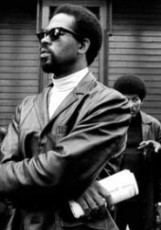The Demise of the Prison Revolutionary: 1950-1980
I just finished Eric Cummins’s book “The Rise and Fall of California’s Radical Prison Movement.” The book is well-worth reading.
Cummins mainly focuses on three San Quentin prisoners: Carl Chessman (Cell 2455 Death Row), Eldridge Cleaver (Soul on Ice), and George Jackson (Soledad Brother) to tell the story of the California prison movement from the 1940s through the 1970s. Through his consideration of these men, he explores the changing ways that crime and criminals were perceived over the course of about 35 years. He basically makes the case that the excesses of the Left (particularly in the 1960s) helped to strengthen the hand of the reactionary Right.
According to Cummins, in the 1940s, Clinton Duffy, a liberal minded Warden at San Quentin prison re-introduced the idea of reading as useful to the rehabilitation of inmates. Prisoners quickly moved from simply reading to writing their own articles, letters, and books. Death Row inmate Carl Chessman in particular wrote a well-received book and several other manuscripts in the 1950s. Chessman basically used his writing as a way to argue that he had become a different person in prison, that he had been rehabilitated and should therefore not be executed. A number of activists came to his defense but he was still executed in San Quentin’s gas chamber in 1960.
Cummins underscores the roles played by various groups in the prison movement. He addresses the contributions of the Black Muslims, the Black Panthers, the prisoner union movement and others. He suggests that adherence to these movements by prisoners led to a severe backlash by the state which sought to put down violence inside prisons.
Cummins reserves a lot of his disappointment in the book for many on the Left who seemed to truly believe and even convinced some prisoners to believe that they would become the vanguard of the coming “revolution.” Cummins was and is a prison reformer and he suggests that this false hope which bordered on delusion did not serve prisoners well at all and in fact contributed to increasing punitive measures inside prisons by the late 1970s. San Quentin, for example, made a U-turn from focusing on rehabilitation to strict punishment in the late 1970s. The prison decided to de-emphasize education and its library shrunk from 36,000 to 9,000 volumes. For Cummins, prisoners simply became the pawns for other external forces and movements.
One of the most interesting things that I learned from Cummins was that in-cell televisions were introduced in the 1970s in order to help pacify prisoners. Prisoners began to watch television and stopped writing “revolutionary” articles and books. I hadn’t ever made this connection so it was a welcome thing to learn.
The book ends with a focus on some developments in the California prison system in the 1990s. He focuses particularly on the system of total control at the Special Housing Unit (SHU) at Pelican Bay. He views Pelican Bay as an extension of the backlash from the 1960s. He writes that “this new institution has been designed expressly to minimize human contact, turning the men who most need to learn to be humane further away from humanity and the world” (p. 271). He warned that prisons like the Special Housing Unit at Pelican Bay would be likely to engender resistance from prisoners in the future because of their draconian practices. He was prescient since prisoners at Pelican Bay have been engaging in hunger strikes for the better part of the last two years protesting against their treatment by prison officials.
It is clear that several other external forces contributed to the rise of the reactionary Right’s “tough on crime” policies and Cummins’s work doesn’t explain all of these social forces. However, the book makes a valuable contribution to our understanding of a pivotal time in the Penal history of the U.S. He helps us to chart the rise and the fall of the American Prison Revolutionary. I recommend the book.

